This scheme for government hospitals gives patients 5-star treatment like private hospitals

- 1.1KShares
- Facebook894
- Twitter11
- LinkedIn25
- Email45
- WhatsApp145
Falling sick bites because you are forced to go a clinic or hospital, which is a total waste of time, not to mention you come out poorer. But, you know, life… lemons… so you find yourself at the crossroads – should I go to a private or public hospital? Good question.
Healthcare is not cheap if you go to private hospitals, that’s why many opt for public hospitals. But public hospital gotta wait so long, you can feel the cancer moving into Stage 4. So how? Expensive-but-convenient vs cheap-but-slow.

Here’s one option you can check out. It’s called the Full Paying Patient (FPP) scheme, which was introduced in 2007 at select public hospitals. The FPP is perfect for people who want the private hospital experience at a public hospital, and are willing to pay for it, BUUUT at a cheaper rate than private hospitals!
You pay HALF of what you would be charged at private hospitals!
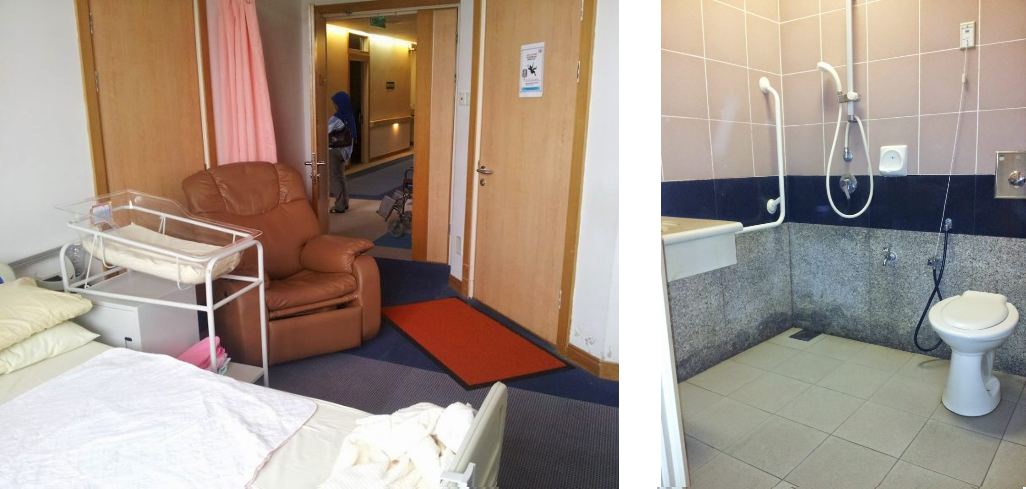
Let’s get one thing straight, the FPP is the Health Ministry’s initiative, so the hospitals and doctors are from the public sector. But because you are a full-paying customer instead of going for the government healthcare subsidy (which is as low as RM1), you sorta get the red carpet treatment and skip the long waiting hours.
On top of that, patients have the liberty of choosing the specialist they want from the participating public hospital that they are going to. One of the scary things about going to a public hospital, for some people, is the thought of being attended to by a newbie who couldn’t find your vein with a telescope… your arm has started to look like a drug addicts’. Mercifully, for FPP patients:
“Pegawai Perubatan Siswazah, pelajar perubatan dan pelatih-pelatih lain tidak sama sekali dibenarkan merawat, melakukan sebarang prosedur dan yang seumpamanya ke atas pesakit FPP.” – plucked from FPP Guidelines
Phew! Patients also get to enjoy better facilities and services than regular patients, for example the First Class Ward and Executive Ward. You also get to select meals from the First Class Ward menu. Did we mention you skip the waiting?
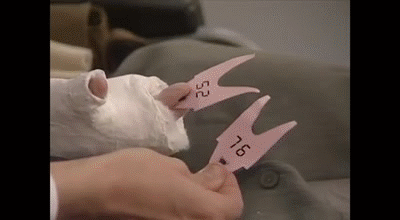
All FPP patients will be charged for each treatment provided and procedure performed by the specialists, plus whatever facilities they select at FULL price. But then what’s the difference between that and a private hospital? The price! FPP price is supposed to be HALF what is offered at private hospitals Bernama reported.
Even better, a family member is allowed to teman the patient for as long as he or she is warded, so they don’t have to drive back and forth every day. Our BM team SOSCILI interviewed a woman who chose FPP for her delivery. Here’s a simple translation of her satisfactory experience. To read the original article in BM, click here.
“The ward is first class, so my husband is allowed to accompany me for 24 hours. It has a toilet and an extra bed for the person accompanying the patient. All transactions at at the counter are also expedited or I can use the fast lane. I don’t have to queue or wait for very long. If there is a problem with the foetus, the specialist would advise me on what to do, all the way up to the labour. If there’s an emergency, patients can go straight to the emergency ward. They only need to show the FPP card and they will be referred to a specialist of their choice.” – Fifi, an FPP user told SOSCILI
Outpatient, admission, and daily treatment are available for the following scope of service:
- General Surgery
- General Medicine
- Obstetrics & Gynaecology
- Orthopaedic (including foot and ankle)
- Ophtalmology
- Paediatrics
- Anesthesiology
- Otorhinolaringology (Ear, Nose & Throat)
- Dentistry (Oral surgery)
- Psychiatry
- Endocrinology (Paediatric and adult)
- Endocrine Surgery
- Spinal Surgery
- Rhinology and Sleep medicine
- Minimally Invasive Surgery
- Endoscopy Gynaecology Surgery
- Patology and Diagnostic Imaging
Nice. So who is eligible to apply for the FPP?
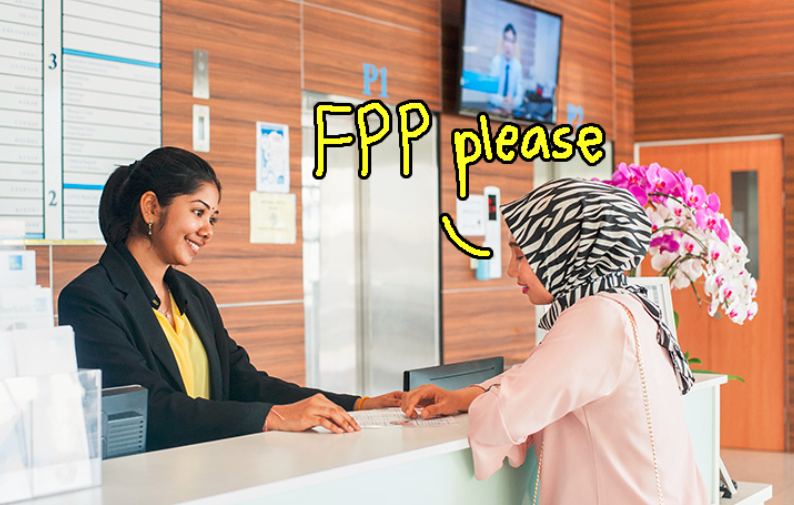
The FPP is a very limited offer and only caters to 30% of the total number of patients in the hospital. So if you want to go for it, you might want to register really early because it fills up quite fast. They take walk-ins and enquiries at the FPP counter in hospitals on working days (8 am-5 pm). Alternatively, you can be referred to it by a government medical doctor or private medical practitioner. To know more, contact 03-83124316, or email [email protected].
Anyone is eligible for this service as long as they (or insurance) are willing to pay for it. It is open to citizens and non-citizens, government employees and also those from the private sector. When you register, you need to sign the FPPS Scheme Agreement Form/Consent Form to agree to pay all the charges, and the charges will begin the minute the form is signed.
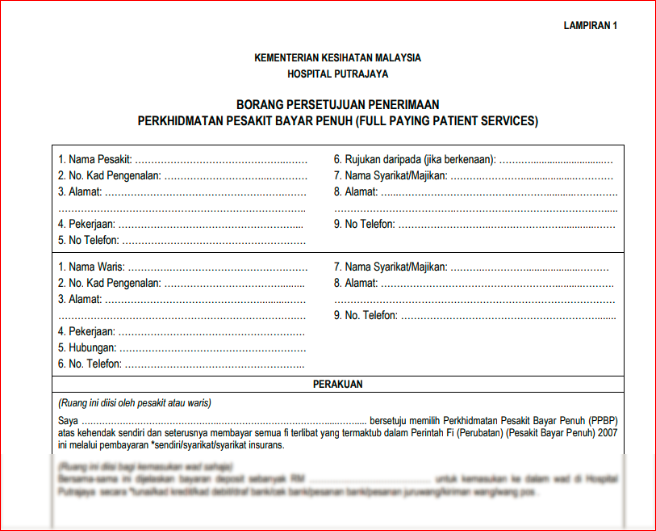
These are the documents you need to bring:
i. IC/Birth Cert/Visa/Passport
ii. Guarantee Letter (GL) from the company or insurance company stating their eligibility for the FPPS Scheme
iii. Deposit
iv. Reference letter/Appointment card (if available)
Speaking of deposit, patients are required to pay either the minimum of RM3,000, or 50% of the estimated total cost of treatment, whichever is higher.
Meanwhile, here is the breakdown of charges for FPP – for registration and consultation, bed, operation theatre, labour room and so on. As for the rest, well, that would depend on the individual’s case.
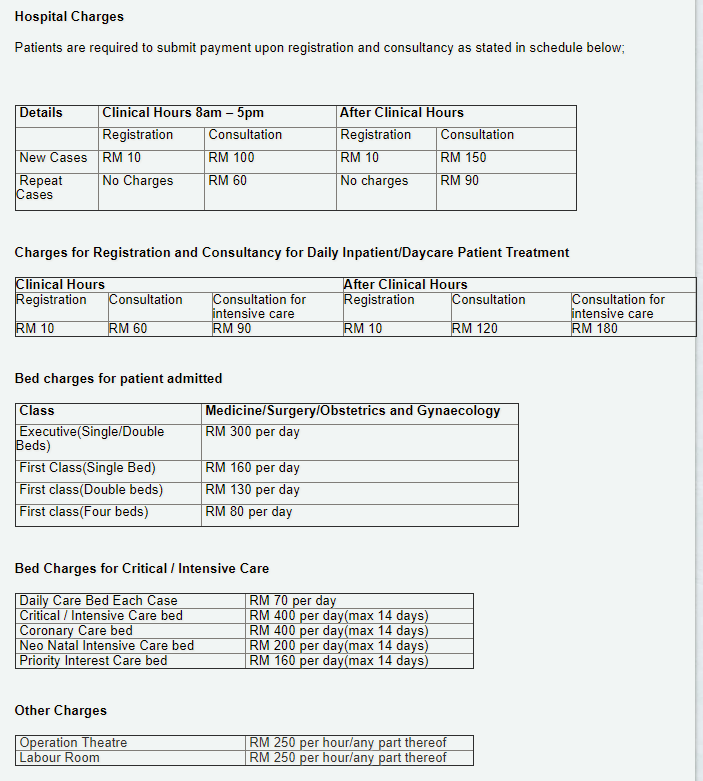
Initially, only Selayang Hospital and Putrajaya Hospital offered this scheme, but it could be expanded to general hospitals in Kota Bharu, Kuala Terengganu, Kuantan, Temerloh, Ipoh, Kuala Lumpur, Klang and Seremban.
Though this scheme sounds awesome, there was a bit of confusion at first. People were afraid that it’s a move to privatise healthcare. Currently, public healthcare in Malaysia is subsidised, said to be one of the cheapest in the world with subsidies at 98%. So, with richer FPP patients offering doctors money, while many other patients don’t have the financial means…
Oh no, what if specialists neglect their other patients for the sake of money?
Here’s something you need to understand about FPP – from the money collected from each treatment, the specialists earn 60% while the remainder is given to the hospital. Now, this has raised a lot of concerns.
The public healthcare subsidy in Malaysia is a relief for the low and even middle income group. But with the existence of FPP, what if the specialists are so busy attending to paying patients that they neglect the others who can’t? Would that mean healthcare would no longer be RM1? You can see why some say that it is a move to privatise healthcare.
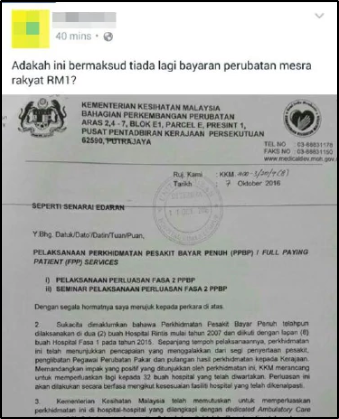
Responding to this, Health Deputy Minister Dr. Hilmi Yahaya said FPP would not affect non-paying patients because firstly, they would still pay only RM1 upwards for treatment. Secondly, he assured that hospitals would not neglect non-paying patients:
“The Ministry will ensure that specialists in government hospitals treat patients who cannot pay before treating patients who opt for the scheme. Therefore, there is no case of neglect of patients who cannot afford to make the payment because the doctor must give priority to their core duty.” – he told reporters
FPP services will only be held on holidays and non-peak times, after official working hours. In a way, it’s like OT for specialists. Additionally, the FPP Guide Book clearly states that if any specialist neglects non-paying patients in the public sector, his service will be terminated.
Actually the FPP is an attempt to retain specialists at public hospitals
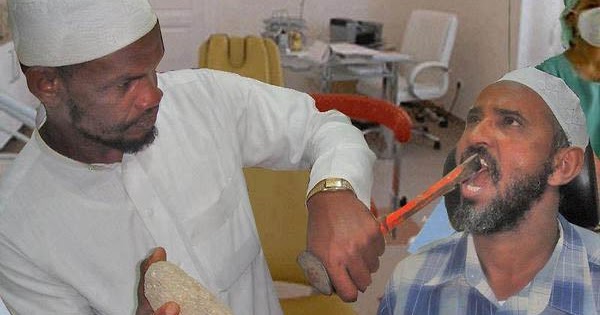
Over the past six years, nearly 150 medical specialists from the public sector resigned from the Health Ministry each year to join the private sector, mainly due to lack of prospects for promotion and progress in their career.
So, the FPP is one of the government’s strategies to address the differences in income between medical specialists in the public and private sectors.
“The FPP programme is only for those who can afford and it is a way to retain specialists at public hospitals and at the same time, capitalise the loop-hole in providing free healthcare for foreigners. We hope with this programme, specialists will stay with us instead of resigning and moving to private health institutions.” – Dr. Hilmi, Malay Mail Online
However, since FPP has been going on for 10 years, some people said the Government could be a little more transparent with its progress la. What are the highlights, drawbacks and lessons learned? Have any specialists resigned since FPP was implemented? How many people have used the services and how much income it has generated, etc.
Scheme or no scheme, it is still a smart idea to stash some emergency cash aside for healthcare… a majority of Malaysians do, this survey found. Or at least get insurance.
- 1.1KShares
- Facebook894
- Twitter11
- LinkedIn25
- Email45
- WhatsApp145



